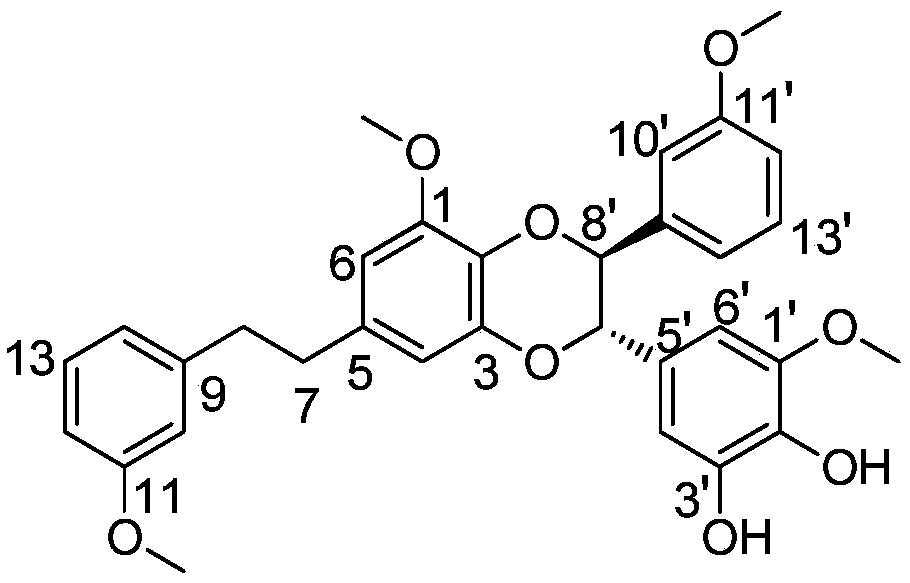Dendrobium nobile dibenzyl component, and extraction, separation and chiral resolution method thereof
A Dendrobium nobile, separation method technology, applied in the field of biomedicine, can solve the problems of more research, less research on the non-alkaloid part of Dendrobium nobile, complex and diverse chemical components, etc.
- Summary
- Abstract
- Description
- Claims
- Application Information
AI Technical Summary
Problems solved by technology
Method used
Image
Examples
Embodiment 1
[0031] A bibenzyl component of Dendrobium nobile, its chemical name is: dimer dendrobium A,
[0032] Its chemical structure is as figure 1 .
[0033] The preparation method of the new composition of the present invention comprises the following steps:
[0034] 1) Take 5 kg of stems of Dendrobium nobile, after drying and crushing, reflux extraction with 90% ethanol by volume fraction for 3 times, and concentrate under reduced pressure to obtain 480 g of ethanol extract;
[0035] 2) After dispersing the ethanol extract in step 1) with 2.0% hydrochloric acid aqueous solution and fully stirring, filter under reduced pressure to obtain acid-water insoluble matter. The acid water-insoluble matter is dissolved in ethanol and then mixed with 100-200 mesh silica gel. After evaporating the solvent, it is first degreased with petroleum ether, then extracted three times with petroleum ether-ethyl acetate 1:1 and ethyl acetate, and concentrated under reduced pressure to obtain Extracts ...
Embodiment 2
[0040] The volume fraction of aqueous ethanol used for the reflux extraction in the above step 1) is 90%, and the reflux extraction is 3 times; the extraction is 3 times in the step 2); the methanol-water with a volume fraction of 90% is used in the step 4); the volume fraction is used in the step 5) 70% acetonitrile-water. The steps are the same as in Example 1, and the beneficial effects described in the present invention can also be obtained.
[0041] The present invention carries out the condition of TLC identification: developer is sherwood oil-ethyl acetate system and methylene chloride-methanol system, chromogenic agent a: observe fluorescence under ultraviolet lamp (254nm); chromogenic agent b: iodine cylinder color development .
[0042] Structural identification: The spectroscopic techniques used mainly include nuclear magnetic resonance spectroscopy ( 1 H-NMR, 13 C-NMR, HSQC, HMBC) and mass spectrometry (HR-ESI-MS) identified the structures of the compounds.
[...
Embodiment 4
[0049] To determine the inhibitory effect of dimer dendrobin A on human hepatoma cell HepG2.
[0050] Using the conventional MTT method, select the above-mentioned cells in the logarithmic growth phase, and adjust the cell concentration to 10×10 with 10% fetal bovine serum culture medium. 5cells / mL, 100 μL per well, inoculated into 96-well flat-bottomed cell culture plate, placed at 37°C, 5% CO 2 After culturing in the incubator for 24 hours, the concentrations of the samples added were 0, 10, 20, 40, 80, and 160 μg / mL, respectively, and 3 replicate wells were set up. At 37°C, 5% CO 2 After continuing to cultivate in the incubator for 48 hours, discard the culture solution with the sample, and then add 100 μL culture solution. Then add 20 μL of MTT solution (5 mg / mL) to each well to continue culturing for 4 hours, discard the supernatant after centrifugation, wash with PBS for 2 to 3 times, and then add MTT-containing culture solution. The culture was terminated, and the cu...
PUM
 Login to View More
Login to View More Abstract
Description
Claims
Application Information
 Login to View More
Login to View More - R&D
- Intellectual Property
- Life Sciences
- Materials
- Tech Scout
- Unparalleled Data Quality
- Higher Quality Content
- 60% Fewer Hallucinations
Browse by: Latest US Patents, China's latest patents, Technical Efficacy Thesaurus, Application Domain, Technology Topic, Popular Technical Reports.
© 2025 PatSnap. All rights reserved.Legal|Privacy policy|Modern Slavery Act Transparency Statement|Sitemap|About US| Contact US: help@patsnap.com



